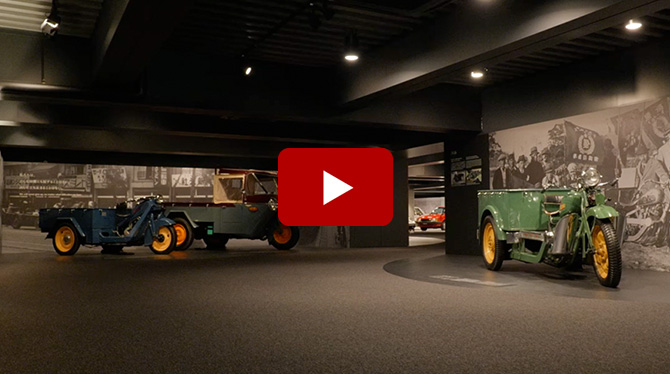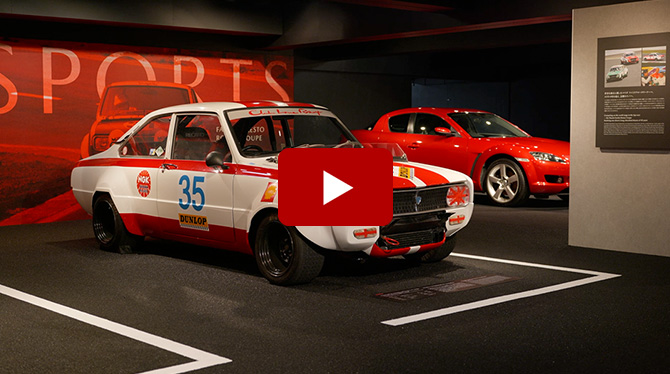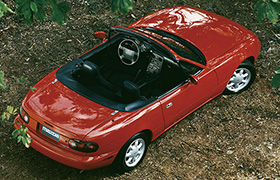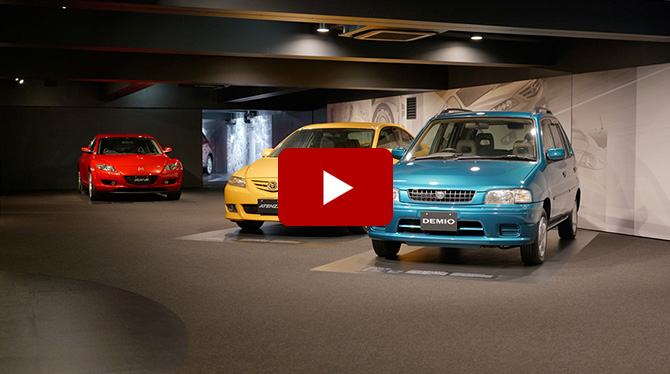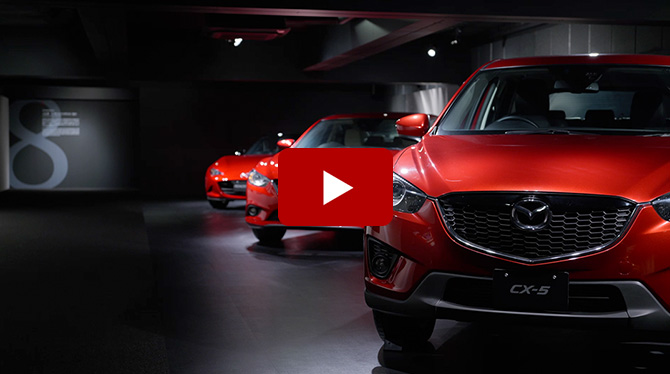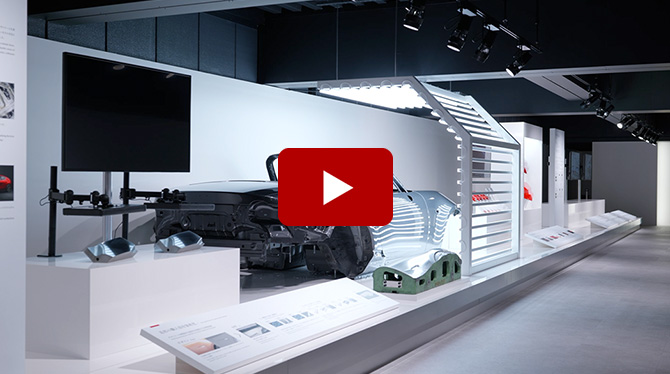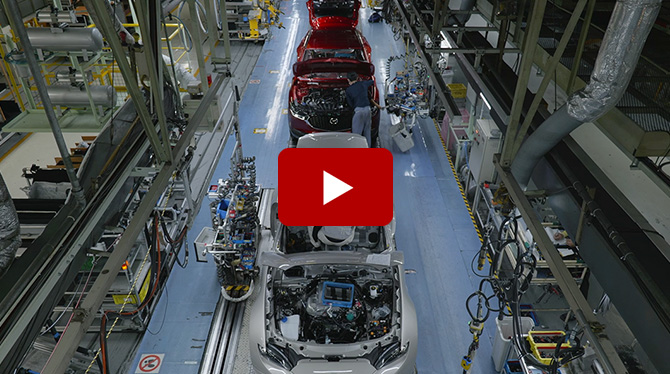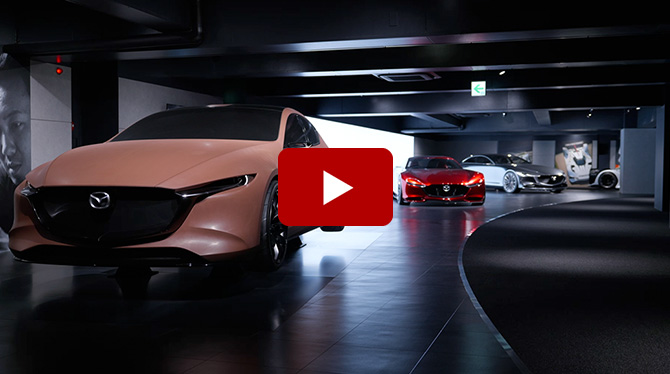Relive the history of car making at Mazda, which has produced many iconic models.
For an even more exciting experience, please visit the Mazda Museum at our Hiroshima Head Office.
We look forward to seeing you soon.
- 1920-1959
- THE ORIGIN OF
MAZDA’S
MANUFACTURING
SPIRIT
ZONE.1
THE ORIGIN OF MAZDA’S MANUFACTURING SPIRIT
Mazda’s founder, Jujiro Matsuda, devoted his life to technology and manufacturing.
At age 13, he apprenticed away from home with a blacksmith in Osaka, followed by jobs at various large plants and munitions factories around Japan in pursuit of ever more advanced technology. Jujiro’s unwavering passion for manufacturing and his strong, independent spirit would eventually lead him to the machinery and automobile industries. Mazda’s dedication to perfecting our trade began with Jujiro.

The red, round Toyo Kogyo logo made to resemble the Chinese character for “manufacturing”.

The landmark three-wheeled truck Mazda-Go (type DA), Toyo Kogyo’s first automobile.
- 1960-1969
- TRANSFORMATION INTO A GENERAL
AUTOMOBILE MANUFACTURER - 1960-1969
- BECOMING AN INTERNATIONAL
BUSINESS
WHILE RESPONDING TO THE
CHANGING TIMES
ZONE.2-3
TRANSFORMATION INTO A GENERAL AUTOMOBILE MANUFACTURER
When Toyo Kogyo expanded into the passenger vehicle market, the company developed its “pyramid vision” product strategy, an expanded, strategic lineup with light vehicles comprising the base and luxury sedans at the top. A range of commercial vehicles, from light trucks to mid-sized trucks, were developed. They mainly used aluminum alloy inline four-cylinder engines, while also beginning to employ rotary engines, called “the dream engine,” through technology alliances with NSU and Wankel in Germany.
Through a technology alliance with Perkins in England, diesel engines were also developed. In just 10 years, Toyo Kogyo had grown from a three-wheeled truck manufacturer to a general automobile manufacturer with a diverse lineup of vehicles and engines.
ZONE.2-3
BECOMING AN INTERNATIONAL BUSINESS WHILE RESPONDING TO THE CHANGING TIMES
Public demand for cars that were safe, had low emissions, and saved resources quickly increased in the 1970s. Toyo Kogyo made it through the second oil crisis and took advantage of global demand for small, light cars to quickly develop its overseas business. In 1979, Toyo Kogyo entered a capital alliance with Ford, expanding the supply of completed vehicles and transmission parts for the American automaker. In order to respond to increased production volume, a new plant was constructed in Hofu, Yamaguchi Prefecture. At the same time, the company introduced “corporate identity,” then a novel concept in Japan, standardizing the company’s visuals by determining a logo and company color. In 1984, the company name and brand name were aligned to “Mazda Motor Corporation.”
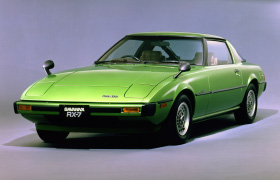
SAVANNA RX-7 (1978)
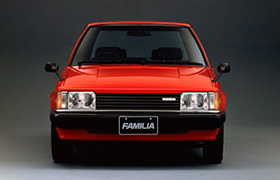
FAMILIA wins Car of the Year Japan (1980)
- MOTORSPORTS
- Making a name for Mazda
and our technology
on the world stage
ZONE.4
Making a name for Mazda and our technology on the world stage
Mazda began participating in motor sports with touring car races in the 1960s. Starting in Asia, before long our vehicles were entering European and North American races, including global rallies such as Le Mans and IMSA. Mazda’s rotary engine, embodying our unflagging challenger spirit, played a major part. It was our mission to demonstrate the durability and outstanding performance of our unique technologies, the pride of Mazda, on the world’s biggest stages.
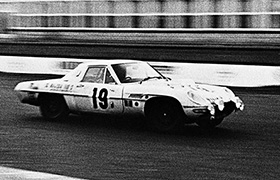
Cosmo Sport, the first Mazda entrant equipped with a rotary engine, entered the Marathon de la Route 84-hour race (Germany).
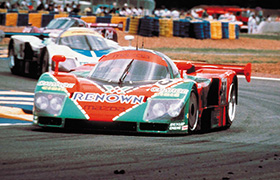
Victory at last. The Mazda 787B became the first Japanese car to finish overall first at the 59th Le Mans 24-hour endurance race.
- Links
- MAZDA MOTOR SPORT
- 1986-1995
- Going on the offensive,
aiming for growth - 1996-2009
- Emphasizing brand strategy,
new plan for growth
ZONE.5-6
Going on the offensive, aiming for growth
In the second half of the 1980s, Mazda strengthened its research and development in order to succeed in an increasingly competitive market. It established a domestic technology research center, as well as R&D centers in Europe and the U.S. Additionally, a U.S. production site, which had been a pending issue, was established in 1987, and domestic sales were also strengthened. In anticipation of market expansion, an ambitious annual sales volume of 800,000 units was set, and sales channels were expanded from three to five. Mazda proactively invested in new products, including imported vehicles. In the following years, the collapse of Japan’s bubble economy forced Mazda to revise its expansion strategy, but this era of the company’s history is still marked by many unique, attractive vehicles.
ZONE.5-6
Emphasizing brand strategy, new plan for growth
In 1997, Mazda introduced its current logo, and the next year it defined its worldwide brand positioning (WWBP). The brand strategy became rooted in the company’s business. Product development aimed to produce cars that conveyed the joy of driving, and Mazda determined the special characteristics of its brand to be distinctive design, exceptional functionality, responsive handling and performance. A new generation of Mazda vehicles embodying these features went on sale: Mazda6 (Atenza), Mazda2 (Demio), RX-8, and Mazda3 (Axela). Additionally, the brand message “Zoom Zoom” (the love of motion experienced as a child) was developed to strengthen Mazda’s global brand. Mazda aimed to offer an exhilarating driving experience.

Starting with the Mazda6 (Atenza), the new generation of products embodying the Mazda brand is released (2002).
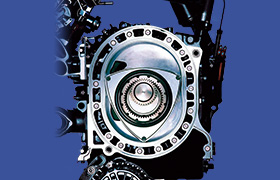
New-generation rotary engine Renesis is developed and equipped in the RX-8 (2003).
- 2010-TODAY
- Aiming for the world’s
best cars with Mazda-unique
design and technology
ZONE.7
Aiming for the world’s best cars with Mazda-unique design and technology
Mazda undertook thorough renewal of its technology, aiming to create the best cars in the world. The new design philosophy pursued the physical expression of vitality, breathing life into the car, and the soul of design. Under Monotsukuri Innovation, Mazda continued to refine the technology and design born from its unflagging challenger spirit.

New design theme that embodies “strong vitality” and “movement expressing speed”
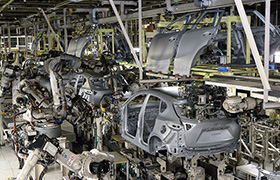
Car manufacturing that embodies both diversity and commonality through coordination between development and production divisions
- TECHNOLOGY
- MONOTSUKURI THAT
PUTS PEOPLE FIRST
ZONE.8
MONOTSUKURI THAT PUTS PEOPLE FIRST
The automobile industry faces various social issues, such as environmental problems and traffic accidents, and is expected to achieve sustainable economic growth and find solutions to these challenges. Even as years pass and society changes, at Mazda we believe in cars’ fundamental value and are committed to pursuing monotsukuri that excites people. With our unflagging challenger spirit and desire to make people’s lives shine through car ownership, Mazda will continue to offer cars that coexist with earth and society.

Sustainable Zoom-Zoom 2030
Through the joy of driving, Mazda aims to help solve issues facing people, the earth, and society.
- ASSEMBLY LINE CREATING QUALITY CARS
FOR EACH CUSTOMER
ZONE.9
CREATING QUALITY CARS
FOR EACH CUSTOMER
Mazda’s assembly lines use mixed model production. Over the year, production has been continuously improved, such as by incorporating scheduled sequential production to increase efficiency and having delivering uncompromising, high-quality products to customers as quickly as possible.
- TOWARD THE NEXT 100 YEARS
- CO-CREATING WITH OTHERS
ZONE.10
CO-CREATING WITH OTHERS
Mazda celebrated its th anniversary on January , . Our passion for monotsukuri began with Jujiro Matsuda, and it will remain unchanged going forward. For Mazda, a car is not simply a mass of metal, and every car we create has a life of its own. Cars are our irreplaceable partners, allowing us to feel the exhilaration of driving and helping us to lead rich, fulfilling lives. By always cherishing Mazda’s unique quality of putting people first and with appreciation for all those who support us, we will create the next years of Mazda.
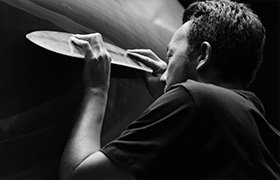

- Links
- MAZDA DESIGN

